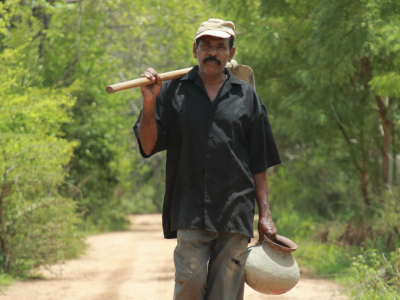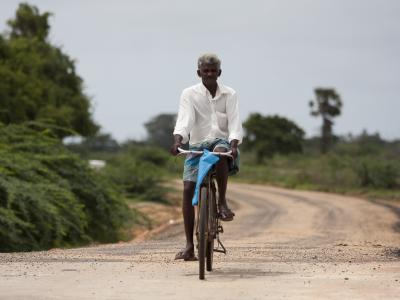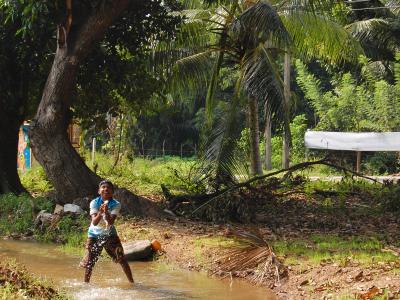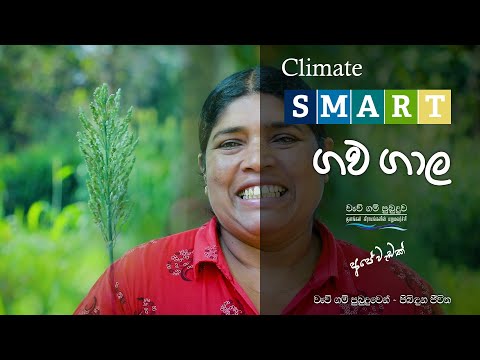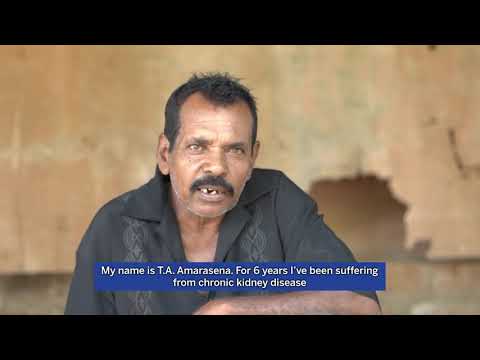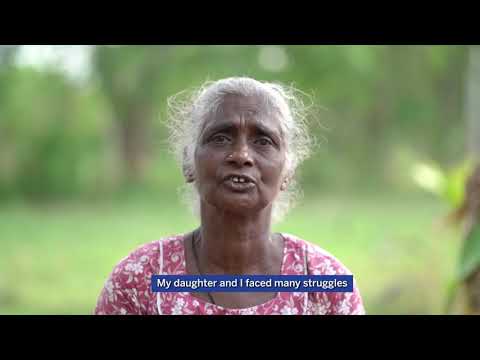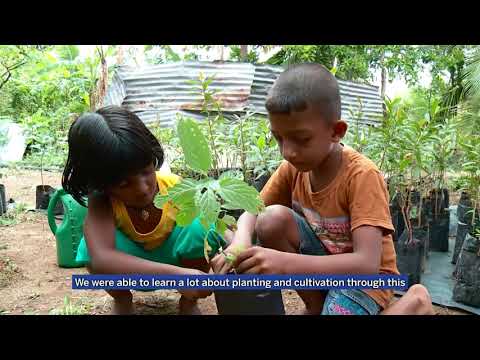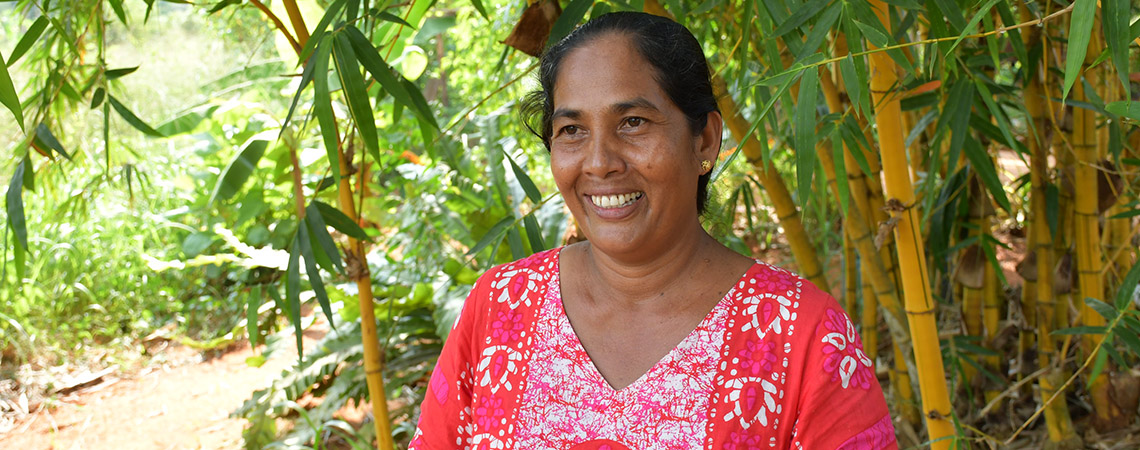
Photo:
The project 'Strengthening the Resilience of Smallholder Farmers in the Dry Zone to Climate Variability and Extreme Events' (2017-2024) is working to address water quality and quantity issues impacting people who are dependent upon village irrigation systems in the Dry Zones of Sri Lanka.
With mounting concerns about the impact of climate change on the agriculture sector, the Government of Sri Lanka is paying the highest attention to this intensifying crisis in the Dry Zone. Concerns are especially elevated due to the prevailing incidence of Chronic Kidney Disease of unknown etiology (CKDu), for which poor-quality water is cited as a contributing factor, and is increasing at an alarming rate in the Dry Zone. Recent experiences show that current climate forecasting and early warning systems have to be improved, in addition to structural and institutional solutions, to comprehensively address the impacts of the climate change on the agriculture sector.
By addressing these concerns, the Government of Sri Lanka will help the large proportion of Sri Lankan people who are dependent upon livelihoods connected to agriculture and reverse the loss of production from climate-related hazards to improve food security and livelihood opportunities.
- District
- Country Office
- National Governments
2 million, especially smallholder farmers in the Dry Zones in Sri Lanka
- Ministry of Environment, Sri Lanka
- United Nations Development Programme (UNDP)
- Green Climate Fund
Expected outcomes
Output 1: Upgrading and enhancing resilience of village irrigation systems and scaling up climate-resilient farming practices in three river basins of the Dry Zone.
Output 2: Enhancing climate-resilient, decentralized water management solutions to provide safe year-round drinking water to drought vulnerable communities.
Output 3: Strengthening climate and hydrological observing and forecasting systems to enhance water management and adaptive capacity of smallholder farmers to droughts and floods.
Sri Lanka’s recent economic gains, following the end of a debilitating 30 year war and the aftermath of the 2004 Indian Ocean Tsunami, are being threatened due to its increasing vulnerability to climate change which is characterized by increasing temperatures and unpredictability of rainfall. Almost 80% of poor Sri Lankans live in the rural areas and depend on agriculture for food and income. IPCC’s fifth assessment report predicts that South Asia, including Sri Lanka, is vulnerable to drought, flood, food shortages and heat-related mortality. The country has been experiencing severe shifts in its seasonal rainfall patterns accompanied by increased flood and drought in the last decade directly impacting rural food security and incomes.
While categorized as a middle-income country, Sri Lanka masks a complicated situation with deep regional disparities in wealth and wellbeing. About 5.2 million people — equivalent to a quarter of the population — were estimated to be undernourished in 2014. This persistence of rural poverty, indebtedness and vulnerability, high youth unemployment at 19%, low participation of women in the labour force and large-scale migration in search of employment all indicate a high level of unevenness in growth and opportunity across the provinces and districts. Poverty and social exclusion are most prevalent in under-developed rural districts where agriculture is the major livelihood. The conflict-affected districts in the Northern and Eastern Provinces and peripheral districts are most deprived where many years of exclusion from the benefits of a steady economic growth and development resulted in greater social vulnerabilities.
Dry Zone Context – agricultural livelihoods, poverty, and conflict
The Dry Zone is one of three climatic zones (dry, intermediate and wet) that divide Sri Lanka on the basis of variations in rainfall. It receives less rainfall than average and has pronounced dry periods. The Dry Zone covers 70% of the island’s land area and is the country’s agricultural heartland and the main area where the staple rice is grown. Small-scale farmers with land holdings of less than 2 hectares dominate agriculture in this region. Many other forms of employment in the Dry Zone are also related to agriculture – e.g. agricultural marketing, transport, and financial services. About two-third of the cultivated area in the country is rain fed or irrigated by numerous semi-rainfed minor reservoirs and diversions, collectively referred to as village irrigation schemes. A number of studies confirm that smallholder farmers cultivating under village irrigation systems are poorer and more vulnerable than their Dry Zone counterparts who have access to major irrigation. Such farmers are much more vulnerable to impacts of climate change than farmers cultivating under larger irrigation systems. As productivity and crop yields decline with low water availability and unseasonal rains resulting from climate variability and extreme events, farmers are dragged deeper into poverty and face food deficits, which have to be met by buying food for consumption, increasing the level of indebtedness and further eroding their capacity to cope with climate risks.
While the impacts of the conflict were experienced throughout the country (eg. suicide bombing and attacks on public places, economic downturn, social issues with war casualties), several districts in the Dry Zone were directly affected by the fighting and resultant large-scale displacement. The five districts of the Northern Province, three districts in the Eastern Province and peripheral districts such as Puttalam, Anuradhapura, Moneragala and Polonnaruwa were directly impacted by the war. This is about 60% of the country’s land area and around two thirds of the coastline of the country. The end of the war in 2009 has allowed many of these districts to re-enter the economic mainstream. However, serious challenges remain in completing resettlement and meaningful resumption of economic activities in this region, complicated by frequent and recurrent climate-induced disasters and extreme weather events in the last five years. Recurrent floods and droughts in the last 5-6 years have battered all the districts struggling to overcome the direct impacts of conflict with severe impacts on food security, income, and water for drinking and sanitation of displaced/resettled communities as well as those living in remote border districts.
A paradigm shift in addressing adaptation needs among farmers in the Dry Zone lies in developing an integrated, holistic approach to water security that considers the entire ‘cascade’ or sub-basin system and the inter-connectedness of the village irrigation systems, agricultural practices, and water supply and management techniques for multiple uses, including drinking water. Village irrigation systems (VIS) provide communities with a means of coping with seasonal variability; and, improving their functionality is seen as a means of adaptation to climate change. Increased resilience to floods and droughts require cost-effective design changes and enhancements to the system to reduce flood damages and improve dry-season storage. Efficient, planned, climate-risk informed water management at field and sub-basin level should complement improved availability and access to water. This includes resilient and ecologically sustainable agricultural practices, which substantially deviate from current field practices. Introduction of improved, short duration rice and other crops, simple micro irrigation techniques, semi-mechanisation for water efficiency etc. can ensure longer water storage and availability for multiple uses. Many villages secure their drinking water from wells that are immediately downstream of the village reservoir. Increased water capture and storage will improve both year round access to drinking water and improved agricultural practices, including the reduction of agro-chemical use, will in the long-term improve the quality of drinking water. Harvesting rainwater at household-level can also improve access to quality drinking water as rainwater is considerably safer and of better quality than ground water in the Dry Zone. In addition, early warning information, based on meteorological and seasonal forecasts, is a key part of the water management system. It enables preparation and mitigating measures to be enacted ahead of climate-related disasters and variability ensuring the optimal management of water resources.
Integrated Water Resources Management: Creating a Positive Ripple Effect by UNDP Sri Lanka on Exposure
'One million trees for villus and cascades' - UNDP Sri Lanka, March 21, 2019. The ‘Climate Resilient Integrated Water Management Project’ (CRIWMP) has started a tree planting programme with a target of planting one million trees by the end of the project. Together with different private sector partners, the project has planted 8,500 trees in the last 3 months and is on its way to plant thousands more.
'Countering climate change with the cascade effect: A small-reservoir revival in Sri Lanka’s Dry Zone' - Relief Web, January 9 2019. Researchers from the International Water Management Institute (IWMI) join GCF-funded efforts to rehabilitate “tank” (or small reservoir) cascade systems in the Dry Zone of Sri Lanka.
Project progress report - UNDP Sri Lanka, September 25, 2018. One year after its launch, report outlines key progress on the three components of the project, including community engagement, upgrade of village irrigation systems, water management and climate information and forecasting.
'Lessons from our kings of yore for a parched land' - The Sunday Times, June 17, 2018.
'Finding Nature-based Solutions to Treat Drinking Water to support Farmers in Sri Lanka’s Dry Zone' - Lankapuvath National News Agency of Sri Lanka, March 29, 2018.
'From floods to drought and back: Getting weather-ready and climate-smart in Sri Lanka’s Dry Zone' - March 26, 2018. World Water Day and World Meteorological Day are a time to draw attention to the challenges communities face, but also the solutions.
'Transforming communities of Sri Lanka's Dry Zone' - UNDP Sri Lanka, February 9, 2018. What is the 'Climate Resilient Integrated Water Management Project'? Why is it important and who will it benefit?
'Sri Lankan civil society poised to support Green Climate Fund project in the Dry Zone' - UNDP Sri Lanka, 8 December 2017. Four leading civil society organizations have been inducted as partners in the newly-launched Green Climate Fund-supported project in the Dry Zone, ensuring communities will play a leading role in building their own resilience to climate change.
'Inception Workshop of the Climate Resilient Integrated Water Management Project held in Colombo' - UNDP Sri Lanka, 12 September 2017. At the inception workshop in Colombo, Mr. Anura Dissanayake, Secretary, Ministry of Mahaweli Development and Environment said, “Under this project, over the next seven years, we will work with UNDP and other government institutions to strengthen the resilience of vulnerable smallholder farmers in the country’s Dry Zone who are facing increasing risks of rising temperatures, erratic rainfall, and extreme events attributable to climate change”.
'UN commences $38.1 million green climate project in Sri Lanka' - Ceylon News, 18 October 2016. The UN on Tuesday officially commenced the Green Climate Project (GCP) to support Sri Lanka dry zone communities to adapt to climate change. UN Resident Coordinator for Sri Lanka, Una McCauley officially on Tuesday presented President Maithripala the commencement of the new USD 38.1m GCF project which will be implemented by UNDP. At the 13th GCF Board Meeting in Colombo in July, Sri Lanka secured climate finance of USD 38.1 million for its proposal titled, 'Strengthening the Resilience of Smallholder Farmers in the Dry Zone to Climate Variability and Extreme Events in Sri Lanka'.
'Sri Lanka Secures Climate Finance to Strengthen the Resilience of Smallholder Farmers in the Dry Zone' - UNDP, 18 July 2016. At the 13th Board Meeting of the Green Climate Fund (GCF), the main international funding body for climate action, USD 38.1 million was approved in funding for Sri Lanka for its proposal titled Strengthening the Resilience of Smallholder Farmers in the Dry Zone to Climate Variability and Extreme Events in Sri Lanka.
'Smallholder Farmers Vulnerable To Climate Change', Colombo Telegraph, June 18, 2016 - With changes in rainfall intensity, floods and with slow onset impacts of climate change such as droughts, Sri Lankans feel the daily impacts of climate change. In order to address the situation in which the farmers of the Dry Zone live, actions on adaptation need to be taken. And to do this, there needs to be finance allocations - such as via the Green Climate Fund.
Sri Lanka GCF-funded project builds climate resilience of farmers
Output 1:Upgrading and enhancing resilience of village irrigation systems and scaling up climate-resilient farming practices in three river basins of the Dry Zone
Activity 1.1 Improve technical capacity and knowledge management targeting ASCs, local field officials and community organisations for climate-risk informed water management and climate-smart agriculture
This activity will support the development of cascade level water management plans and guidelines that incorporate climate risks and impacts in a participatory, multi-stakeholder approach. It will include training for FOs and other CBOs (women’s groups) to implement and maintain the project investments in light of a changing climate. The activity will improve collaboration for planning and equitable water sharing between users in a cascade. ASCs in the river basin will be developed as knowledge and communication hubs including supporting cross-district, cross ethnic experience sharing through exchange field visits and field training programmes. It will address the barriers of limited technical capacity, institutional coordination, and knowledge for integrated approach to climate-risk informed water and agriculture management.
Activity 1.2 Improve resilience of and upgrade village irrigation systems in the identified cascades including restoration of upstream watersheds
GCF resources and government co-financing will be used to support the design and upgrades of VIS, incorporating elements to enhance the resilience of these systems to climate change risks and impacts. About 325 village irrigation systems, including the upstream catchments, will be upgraded based on the cascade level water development plans. The interventions to upgrade the irrigation systems include: i. reforesting the watershed and re-introducing the vegetative interceptor to trap contaminants: ii. Restoring the reservoir bund (dam), spill, sluice and canals supplying the fields, and iii. Desilting the reservoir bed. These upgrades will incorporate climate risks and combine traditional and new design elements and practices including partial de-silting to deepen reservoirs close to the bund and retain more water during dry seasons, intensified reforesting of the catchment with multi-purpose trees, creating ponds and diversions for run-off capture in the catchment, upstream soil conservation practices like hedgerows, contour drains to prevent erosion, and creating small ponds in home gardens to capture intense rainfall.
Activity 1.3 Develop and disseminate climate resilient agricultural practices with targeted enterprise development for women
The activity will support government extension services to develop and widely disseminate demand-driven, tested, climate change risk informed agriculture support packages which includes drought/flood resilient crops (seeds), organic inputs, soil and water management technologies and market oriented agro-processing technologies. Together with the seasonal climate forecasts (Activity 3.2) and improved marketing options for the recommended crops (supported by market mapping undertaken through this activity; crop recommendations co-financed by Department of Agrarian Development and Department of Agriculture), the climate resilient agriculture package will provide more food, income and improve ability of farmers to cope with seasonal variability and improve rational use of water. Based on the past experiences from other similar initiatives (e.g. IUCN/HSBC project and SAPSRI Project—refer to Annex II, Feasibility Report, Section 5.3), recommended practices include using short-term and climate resilient traditional rice varieties; landscaping/vegetative barriers for erosion control; crop diversification and composting in home gardens; use of organic fertilizers; crop diversification during the minor season; rational use of chemical inputs based on soil condition; agronomic and crop establishment techniques such as dry sowing in paddy fields in between seasons; and micro irrigation, with due regard to the agro-ecological regions. Resilient agriculture practices recognize the need to address climate-related factors (drought and flood resistant crops, shorter duration field crops) along with non-climate drivers for safe and chemical-free agriculture that contributes to long-term improvement of water quality.
Output 2: Enhancing climate-resilient, decentralized water management solutions to provide safe year-round drinking water to drought vulnerable communities
Activity 2.1 Improve capacity of water-supply support staff at district/divisions, selected partner organisations (NGOs) and CBOs to implement and maintain community-based climate change risk informed drinking water related interventions
Village irrigation reservoirs are a key source of drinking water in the Dry Zone. As such, the expected risks on drinking water on both the supply and demand side as climate change needs should be incorporated into the cascade water management plans in Output 1. The activity focuses on planning and capacity building to address the barriers of technical capacity and institutional coordination related to provision of safe drinking water to the Dry Zone communities. The capacities of local officials and women-led CBOs will be strengthened for climate-risk management related to drinking water sources, supply systems, and quality monitoring and management. The activity will support training and mobilization to ensure the drinking water needs in light of a changing climate are incorporated into cascade development plans implemented through cascade-level water committees and water source protection committees. It will also build capacities for climate-risk informed planning for water source protection and quality monitoring coordinating with NWSDB. These will inform the selection of climate-risk informed treatment methods appropriate for the water sources.
Activity 2.2 Implement sustainable, climate-resilient drinking water solutions through CBOs and government agencies
GCF resources and government co-financing will be invested to establish climate-resilient, community water systems (with simple treatment) for water extracted from irrigation systems and domestic rainwater harvesting (RWH) systems to supplement drinking water during prolonged dry periods. In addition, advanced purification and filtrations systems will be established to supplement long-term measures such as ecological agronomic practices (Output 1) that impact drinking water quality. This activity addresses the technical and financial barriers related to investments in rural water supply schemes, improved water treatment and purification schemes and domestic rainwater harvesting units. The design and operation of these systems will incorporate climate risks and information (including advisories and forecasts generated under Output 3) and will be fully integrated into the cascade water management planning (Output 1).
Output 3: Strengthening climate and hydrological observing and forecasting systems to enhance water management and adaptive capacity of smallholder farmers to droughts and floods
Activity 3.1 Establish effective monitoring systems for drought, floods and water management
This activity expands the meteorological and hydrological observational network coverage by installing, operating and maintaining monitoring equipment in key catchments and VIS systems. This will enable DAD, ID and FOs to better understand and monitor current conditions within the cascade systems, as well as streamflow, which may cause flooding of agricultural areas further downstream. Agrometeorological data will be used to estimate a suite of products including evapotranspiration and soil moisture, which will help detect the onset of agricultural droughts. Along with 10 automatic rainfall gauges the rainfall data will be used to support the development of satellite-based estimates in activity 3.2. Additionally these data can help refine MOS-based forecasts (see 3.2), once a suitably long time-series (approximately 3-5 years) becomes available. Automated water level sensors (50) will be used by DAD and ID to monitor water levels at critical points in the three river basins, which along with 8 streamflow gauges, will allow early detection of rising flood waters. Water levels and rainfall will be monitored in VIS systems by FOs and farmers using 330 manual staff (water-level) and rainfall gauges.
Activity 3.2 Co-develop and disseminate weather- and climate-based advisories for agricultural and water management through ASCs and FOs to farmers and village water managers
This activity address institutional capacity and financial barriers related to provision of early warnings and forecasting. It supports the eestablishment of protocols and SOPs for generating, sharing and using weather data and information between national agencies (DoM, DAD, ID and DMC) and ASCs/FOs. It will involve the sensitization of communities and FOs to the availability of weather and climate information, as well as the function of any local equipment, which will be used to generate data used in the advisories. Through this activity a sense of ownership will be cultivated to avoid vandalism of equipment etc. The sense of ownership will be further promoted through co-development of information requirements for agriculture and water management. A training of trainers to use and adapt weather/climate based advisories will be undertaken to enable FOs and lead farmers to understand the historical context of climate information as a basis for understanding the implication of and using weather and seasonal forecasts.
Activity 3.3 Develop climate-risk management response measures based on advisories and forecasts for agriculture, water management and flooding in cascade systems
This activity will develop and plan appropriate climate risk management responses to the advisories developed through activity 3.2, including the additional impacts expected through climate change. This will involve inundation area mapping of areas in the three river basins prone to flooding in order to set the baseline flooding scenarios expected without climate change.
- UNDPYusuke TaishiSenior Technical Adviser, Climate Change Adaptationyusuke.taishi@undp.org















